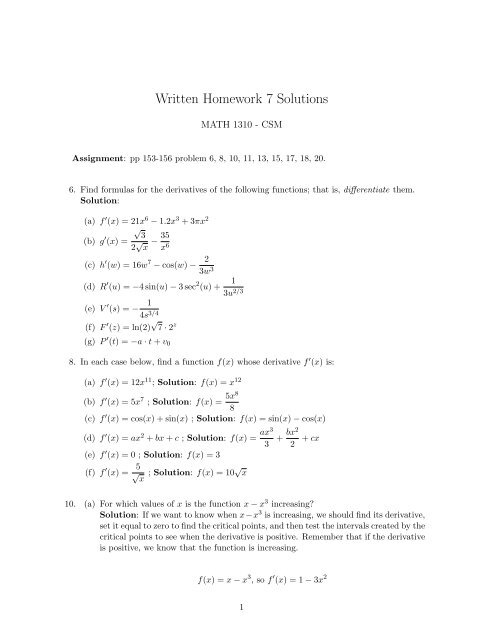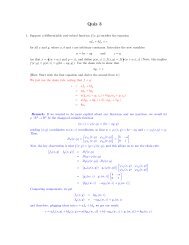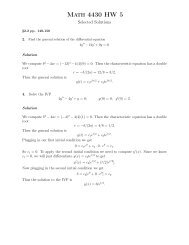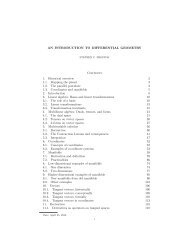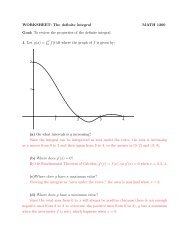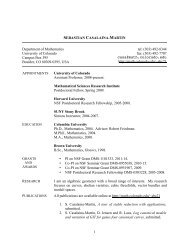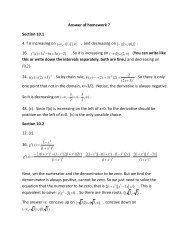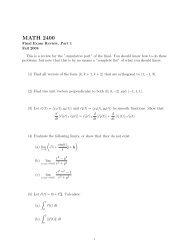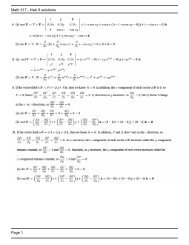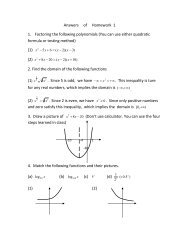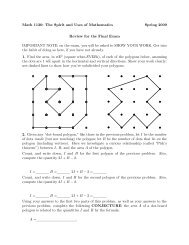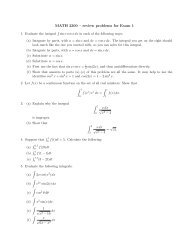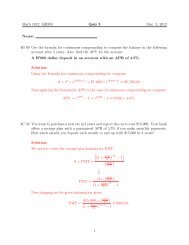Written Homework 7 Solutions
Written Homework 7 Solutions
Written Homework 7 Solutions
You also want an ePaper? Increase the reach of your titles
YUMPU automatically turns print PDFs into web optimized ePapers that Google loves.
<strong>Written</strong> <strong>Homework</strong> 7 <strong>Solutions</strong><br />
MATH 1310 - CSM<br />
Assignment: pp 153-156 problem 6, 8, 10, 11, 13, 15, 17, 18, 20.<br />
6. Find formulas for the derivatives of the following functions; that is, differentiate them.<br />
Solution:<br />
(a) f ′ (x) = 21x6 − 1.2x3 + 3πx2 (b) g ′ √<br />
3<br />
(x) =<br />
2 √ 35<br />
−<br />
x x6 (c) h ′ (w) = 16w 7 − cos(w) − 2<br />
3w3 (d) R ′ (u) = −4 sin(u) − 3 sec 2 (u) + 1<br />
3u 2/3<br />
(e) V ′ (s) = − 1<br />
4s 3/4<br />
(f) F ′ (z) = ln(2) √ 7 · 2 z<br />
(g) P ′ (t) = −a · t + v0<br />
8. In each case below, find a function f(x) whose derivative f ′ (x) is:<br />
(a) f ′ (x) = 12x 11 ; Solution: f(x) = x 12<br />
(b) f ′ (x) = 5x 7 ; Solution: f(x) = 5x8<br />
8<br />
(c) f ′ (x) = cos(x) + sin(x) ; Solution: f(x) = sin(x) − cos(x)<br />
(d) f ′ (x) = ax 2 + bx + c ; Solution: f(x) = ax3<br />
(e) f ′ (x) = 0 ; Solution: f(x) = 3<br />
(f) f ′ (x) = 5<br />
√ x ; Solution: f(x) = 10 √ x<br />
3<br />
+ bx2<br />
2<br />
10. (a) For which values of x is the function x − x 3 increasing?<br />
Solution: If we want to know when x−x 3 is increasing, we should find its derivative,<br />
set it equal to zero to find the critical points, and then test the intervals created by the<br />
critical points to see when the derivative is positive. Remember that if the derivative<br />
is positive, we know that the function is increasing.<br />
+ cx<br />
f(x) = x − x 3 , so f ′ (x) = 1 − 3x 2<br />
1
Now set f ′ (x) = 0<br />
1 − 3x 2 = 0<br />
1 = 3x 2<br />
1<br />
3 = x2 , hence<br />
<br />
1<br />
x = ±<br />
3<br />
So we need to test the following intervals: (−∞, −<br />
<br />
1<br />
3<br />
<br />
1 ), (− 3 ,<br />
<br />
1<br />
3 ) and (<br />
<br />
1<br />
3<br />
, ∞).<br />
By plugging in points from these intervals into f ′ (x), we can figure out the behavior<br />
of f(x). These calculations have been omitted, but f ′ (x) > 0 for x ∈ (−<br />
thus f(x) is increasing on this interval.<br />
1<br />
3 ,<br />
1<br />
3 ),<br />
(b) Where is the graph of y = x − x3 rising most steeply?<br />
Solution: We want to know when y = x − x3 is rising most steeply. We know it has<br />
1<br />
to be in the interval (− 3 ,<br />
<br />
1<br />
3 ) since this is the only time when f is increasing. One<br />
way to figure out when f is rising most steeply is to look at the second derivative. If<br />
f ′ (x) = 1 − 3x2 , then f ′′ = −6x. Now we set f ′′ (x) = 0 to find its critical points and<br />
we see that f ′′ (x) = 0 when x = 0. Notice f ′ (0) = 1 > 0 so x = 0 is a maximum for<br />
f ′ (x). So to answer our original question, f is rising most steeply when x = 0.<br />
(c) At what points is the graph of y = x − x 3 horizontal?<br />
Solution: We have already seen that the critical points of f are at x = ±<br />
<br />
1<br />
3<br />
. Recall<br />
that f obtains its critical points when f ′ (x) = 0. So f(x) is horizontal, or of zero<br />
slope, or f ′ (x) = 0, when x = ±<br />
1<br />
(d) Make a sketch of the graph of y = x − x 3 that reflects all these results.<br />
Solution:<br />
3 .<br />
-2.5 -2 -1.5 -1 -0.5 0 0.5 1 1.5 2 2.5<br />
2<br />
1.6<br />
1.2<br />
0.8<br />
0.4<br />
-0.4<br />
-0.8<br />
-1.2<br />
-1.6
11. (a) Sketch the graph of the function y = 2x + 5<br />
on the interval 0.2 ≤ x ≤ 4.<br />
x<br />
Solution:<br />
20<br />
15<br />
10<br />
5<br />
0 0.5 1 1.5 2 2.5 3 3.5<br />
(b) Where is the lowest point on that graph? Give the value of the x-coordinate exactly.<br />
Solution: The lowest point on this graph occurs when 0.2 ≤ x ≤ 4 and f ′ (x) = 0.<br />
Since f(x) = 2x + 5<br />
x , f ′ (x) = 2 − 5<br />
, and after some simple algebra, we see that<br />
x2 f ′ <br />
5<br />
(x) = 0 when x = . Thus the lowest point on this graph is ( , 6.3246).<br />
5<br />
2<br />
13. This problem was not graded and is very similar to 15.<br />
15. (a) Write the microscope equation for y = √ x at x = 3600.<br />
Solution: The microscope equation is y ≈ √ 3600 + △y = 60 − 1<br />
· △x.<br />
120<br />
(b) Use the microscope equation to estimate √ 3628 and √ 3592. How far are these estimates<br />
from the values given by a calculator?<br />
Solution: Using the above microscope equation, we will first estimate √ 3628. To<br />
figure out our estimate for y, we first need to find △x: △x = 3600 − 3628 = −28.<br />
Now we can plug into y ≈ 60 − 1<br />
1<br />
· △x. So y ≈ 60 − · (−28) ≈ 60.23333. If we<br />
120<br />
plug √ 3628 into a calculator we get 60.23388, so there is very little discrepancy.<br />
Now we can estimate √ 3592. We first need △x: △x = 3600 − 3592 = 8. Thus<br />
y ≈ 60 − 1<br />
1<br />
· △x. So y ≈ 60 −<br />
120 120 · (8) ≈ 59.93333. If we plug √ 3628 into a<br />
calculator we get 59.933296, so again there is very little discrepancy.<br />
17. A ball is held motionless and then dropped from the top of a 200 foot tall building. After<br />
t seconds have passed, the distance from the ground to the ball is d = f(t) = −16t 2 + 200<br />
feet.<br />
3<br />
120<br />
2
(a) Find a formula for the velocity v = f ′ (t) of the ball after t seconds. Check that your<br />
formula agrees with the given information that the initial velocity of the ball is 0<br />
feet/second.<br />
Solution: Since we’re given that v = f ′ (t) and f(t) = −16t 2 + 200, it’s easy to see<br />
that v(t) = −32t. Now we can check that v0 = 0: v(0) = −32 · 0 = 0.<br />
(b) Draw graphs of both the velocity and the distance as functions of time. What time<br />
interval makes physical sense in this situation? (For example, does t < 0 make sense?<br />
Does the distance formula make sense after the ball hits the ground?)<br />
Solution: The time interval that makes the most sense is 0 ≤ t ≤ 4 since we think<br />
of time starting at zero and the ball hits the ground shortly before t = 4.<br />
160<br />
80<br />
0 0.4 0.8 1.2 1.6 2 2.4 2.8 3.2 3.6 4<br />
-80<br />
-160<br />
y = -16x² + 200<br />
y = -32x<br />
(c) At what time does the ball hit the ground? What is its velocity then?<br />
Solution: The ball hits the ground when d = f(t) = −16t 2 +200 = 0 which happens<br />
when t ≈ 3.54. When t = 3.54, the ball’s velocity is v(3.54) = −32 · 3.54 = −113.14.<br />
18. A second ball is tossed straight up from the top of the same building with a velocity of 10<br />
feet per second. After t seconds have passed, the distance from the ground to the ball is<br />
d = f(t) = −16t 2 + 10t + 200 feet.<br />
(a) Find a formula for the velocity of the second ball. Does the formula agree with given<br />
information that the initial velocity is +10 feet per second? Compare the velocity<br />
formulas for the two balls; how are they similar, and how are they different?<br />
Solution: Again, we know f(t) and that v = f ′ (t), so we get that v = −32t + 10.<br />
(b) Draw graphs of both the velocity and the distance as functions of time. What time<br />
interval makes physical sense in this situation?<br />
Solution: Again, the time interval that makes the most sense is 0 ≤ t ≤ 4.<br />
4
160<br />
80<br />
0 0.4 0.8 1.2 1.6 2 2.4 2.8 3.2 3.6 4<br />
-80<br />
-160<br />
y = -16x² + 10x + 200<br />
y = -32x + 10<br />
(c) Use your graph to answer the following questions. During what period of time is the<br />
ball rising? During what period of time is it falling? When does it reach the highest<br />
point of its flight?<br />
Solution: The ball is roughly rising for 0 < t < 0.31 and falling for 0.31 < t < 3.85.<br />
The highest point is reached when v = −32t + 10 = 0 which occurs when t ≈ 0.31.<br />
(d) How high does the ball rise?<br />
Solution: By plugging t = 0.31 into our distance equation, we see that the ball<br />
reaches f(0.31) = −16(0.31) 2 + 10(0.31) + 200 = 201.56 feet, or 1.56 feet above the<br />
top of the building.<br />
20. A steel ball is rolling along a 20-inch long straight track so that its distance from the<br />
midpoint of the track (which is 10 inches from either end) is d = 3 sin(t) inches after t<br />
seconds have passed. (Think of the track as aligned from left to right. Positive distances<br />
mean the ball is to the right of the center; negative distances mean it is to the left.)<br />
(a) Find a formula for the velocity of the ball after t seconds. What is happening when<br />
the velocity is positive; when it is negative; when it equals zero? Write a sentence or<br />
two describing the motion of the ball.<br />
Solution: v(t) = d ′ (t) = 3 cos(t). When the velocity goes from positive to negative<br />
and visa versa it is simply switching directions on the track from right to left and<br />
left to right respectively. When the velocity equals zero, the ball is at its maximum<br />
distance from the center. The ball is moving back and forth along the track reaching<br />
its higher speeds towards the center of the track and pausing briefly when its distance<br />
from the center is maximized.<br />
(b) How far from the midpoint of the track does the ball get? How can you tell?<br />
Solution: The maximum distance occurs when d = 3 sin(t) is maximized which<br />
5
occurs when v(t) = 3 cos(t) = 0 or when t = π<br />
. Thus the maximum distance is<br />
2<br />
3 sin( π<br />
) = 3 · 1 = 3 inches.<br />
2<br />
(c) How fast is the ball going when it is at the midpoint of the track? Does it ever go<br />
faster than this? How can you tell?<br />
Solution: The first time the ball is in the center of the track after it has started<br />
to move is when d = 3 sin(t) = 0 which occurs when t = π. The speed at t = π is<br />
|v(π)| = |3 cos(π)| = |3 · (−1)| = | − 3| = 3, so the speed of the ball at the midpoint<br />
of the track is 3 inches per second which is the maximum speed.<br />
6


